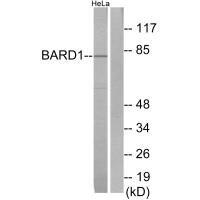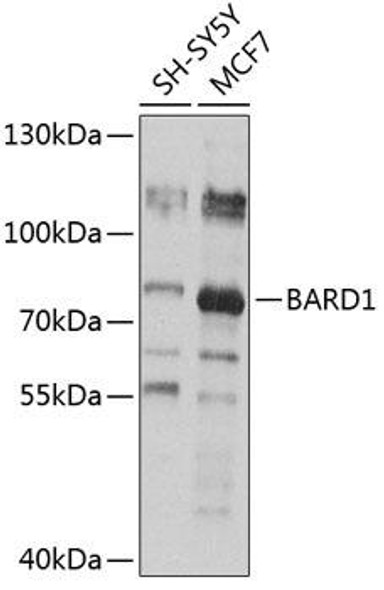Description
| Antibody Name: | BARD1 Antibody (PACO22059) |
| Antibody SKU: | PACO22059 |
| Size: | 100ul |
| Host Species: | Rabbit |
| Tested Applications: | ELISA, WB |
| Recommended Dilutions: | ELISA:1:2000-1:10000, WB:1:500-1:3000 |
| Species Reactivity: | Human |
| Immunogen: | Synthesized peptide derived from N-terminal of human BARD1. |
| Form: | Liquid |
| Storage Buffer: | Rabbit IgG in phosphate buffered saline (without Mg2+ and Ca2+), pH 7.4, 150mM NaCl, 0.02% sodium azide and 50% glycerol. |
| Purification Method: | The antibody was affinity-purified from rabbit antiserum by affinity-chromatography using epitope-specific immunogen. |
| Clonality: | Polyclonal |
| Isotype: | IgG |
| Conjugate: | Non-conjugated |
 | Western blot analysis of extracts from HeLa cells, using BARD1 antibody. |
| Background: | Probable E3 ubiquitin-protein ligase. The BRCA1-BARD1 heterodimer specifically mediates the formation of 'Lys-6'-linked polyubiquitin chains and coordinates a diverse range of cellular pathways such as DNA damage repair, ubiquitination and transcriptional regulation to maintain genomic stability. Plays a central role in the control of the cell cycle in response to DNA damage. Acts by mediating ubiquitin E3 ligase activity that is required for its tumor suppressor function. Also forms a heterodimer with CSTF1/CSTF-50 to modulate mRNA processing and RNAP II stability by inhibiting pre-mRNA 3' cleavage. |
| Synonyms: | BRCA1-associated RING domain protein 1; BARD-1; BARD1; |
| UniProt Protein Function: | |
| UniProt Protein Details: | |
| NCBI Summary: | This gene encodes a protein which interacts with the N-terminal region of BRCA1. In addition to its ability to bind BRCA1 in vivo and in vitro, it shares homology with the 2 most conserved regions of BRCA1: the N-terminal RING motif and the C-terminal BRCT domain. The RING motif is a cysteine-rich sequence found in a variety of proteins that regulate cell growth, including the products of tumor suppressor genes and dominant protooncogenes. This protein also contains 3 tandem ankyrin repeats. The BARD1/BRCA1 interaction is disrupted by tumorigenic amino acid substitutions in BRCA1, implying that the formation of a stable complex between these proteins may be an essential aspect of BRCA1 tumor suppression. This protein may be the target of oncogenic mutations in breast or ovarian cancer. Multiple alternatively spliced transcript variants encoding different isoforms have been found for this gene. [provided by RefSeq, Sep 2013] |
| UniProt Code: | Q99728 |
| NCBI GenInfo Identifier: | 116241265 |
| NCBI Gene ID: | 580 |
| NCBI Accession: | Q99728.2 |
| UniProt Secondary Accession: | Q99728 |
| UniProt Related Accession: | Q99728 |
| Molecular Weight: | 74kDa |
| NCBI Full Name: | BRCA1-associated RING domain protein 1 |
| NCBI Synonym Full Names: | BRCA1 associated RING domain 1 |
| NCBI Official Symbol: | BARD1 |
| NCBI Official Synonym Symbols: | |
| NCBI Protein Information: | BRCA1-associated RING domain protein 1 |
| UniProt Protein Name: | |
| UniProt Synonym Protein Names: | |
| Protein Family: | BRCA1-associated RING domain protein |
| UniProt Gene Name: | |
| UniProt Entry Name: |
| Antibodies |
| BARD1 Antibody (PACO00455) |
| Secondary Antibody |
| Anti-HRP Goat Anti-Rabbit IgG (H+L) Antibody (CABS014) |
| Recommended Products |
| Anti-FITC Goat Anti-Rabbit IgG (H+L) Antibody (CABS011) |
| Anti-HRP-conjugated Beta Actin Antibody (CABC028) |






